Let's shed some light on your search



You are Invited to the Whitman Cemetery Plaquing Ceremony.
Please join us on Wednesday, June 25th, 2:00pm at the Whitman Cemetery Property. Click Here to see poster for details.
Nova Scotia Provincial Heritage Property Act Click Here
County of Annapolis Heritage Property Bylaw Click Here
Clarence United Baptist Church
 The Clarence United Baptist Church, circa 1853, is an impressive fixture in the community of Central Clarence that is atypical for its time in terms of its architectural design and embellishments-a blend of classical and gothic styles.
The Clarence United Baptist Church, circa 1853, is an impressive fixture in the community of Central Clarence that is atypical for its time in terms of its architectural design and embellishments-a blend of classical and gothic styles.
The main body of the Clarence United Baptist Church building is relatively simple and uncluttered; a one and a half storey wood frame construction that outlines the temple pediment characteristic of the Greek Revival Architectural Style with a three bay façade, gothic style tracery windows with label moldings and narrow pilaster or corner boards, typical of many country churches. Added after 1901, the most striking architectural embellishment of the Clarence United Baptist Church is the central open cage belfry tower with crenellated or notched walls and four corner spires.
The Clarence United Baptist Church is a Municipal Heritage Property registered by the Municipality of the County of Annapolis. Officially Registered August 28, 2014.
2659 Clarence Road, Central Clarence
Albany Community Church
 Originally called the New Albany Baptist Church, construction of the Albany Community Church began in 1875 and was dedicated on May 20th, 1877.
Originally called the New Albany Baptist Church, construction of the Albany Community Church began in 1875 and was dedicated on May 20th, 1877.
The church demonstrates beautifully a transitional phase in Nova Scotia Baptist architecture between the early 19th Century meeting houses and the last 19th Century church buildings. The meeting house style is indicated in the overall form of a simple gable roof with double entrance ways while the pointed arches, with shouldered architraves, of the window and door frames herald a Gothic Revival Style.
The Albany Community Church is a Municipal Heritage Property registered by the Municipality of Annapolis County, officially registered, December 20th, 1994.
5939 Highway 10, Albany
Caleb House
 The Caleb House, in the community of Paradise, appears to have been built in 1824, by either John Starratt or his son, Samuel Starratt. The name of this house, Caleb House, is derived from one of its occupants, Caleb S. Phinney, a teacher in the community who owned the house in 1872-1874. Also important in the history of this structure is that from 1874 to 1910, the house operated as the Paradise Baptist parsonage.
The Caleb House, in the community of Paradise, appears to have been built in 1824, by either John Starratt or his son, Samuel Starratt. The name of this house, Caleb House, is derived from one of its occupants, Caleb S. Phinney, a teacher in the community who owned the house in 1872-1874. Also important in the history of this structure is that from 1874 to 1910, the house operated as the Paradise Baptist parsonage.
The Caleb House is an example of a structure that typifies and architectural styling mixture of a modified Classic or Greek Revival form with Gothic Revival detailing. In terms of its Classic or Greek Revival form, Caleb House is a 1½ storey wood construction “gable-end-to-the-road” oriented structure that possesses a medium pitch front gable roof with a one storey hipped roof verandah across the façade that is supported by simple column supports. Gothic Revival styling features of the house includes the use of the decorative bargeboards, flat soffits and a projecting bay window with an ornate bracketed canopy or shed roof, without the typical, curved arch window.
The Caleb House is a Municipal Heritage Property registered by the Municipality of Annapolis County, officially registered July 15, 1997.
10221 Highway 1, Paradise
Captain Joseph Hall House
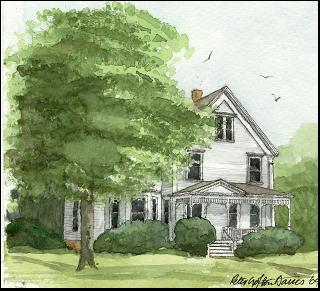 The Captain Joseph Hall House in Granville Ferry is an impressive two-and-one-half storey wooden structure with a brick foundation, constructed in the Greek Revival Style. While the exact date of construction is unknown, it is safe to state that the building was built between 1881 and 1898. The property remained in the possession of members of the Hall family until 1908.
The Captain Joseph Hall House in Granville Ferry is an impressive two-and-one-half storey wooden structure with a brick foundation, constructed in the Greek Revival Style. While the exact date of construction is unknown, it is safe to state that the building was built between 1881 and 1898. The property remained in the possession of members of the Hall family until 1908.
Architectural details of this house include the steeply pitched gable roof with return eaves and pilasters. There are heavy cornices over the windows and dentil moulding embellishing the eave lines. The open veranda features a temple pediment with decorative posts and balustrades. There is also a two storey tall push out on the side of the house with recessed windows. Small windows are located on the northern side of the building and there is a large addition to the rear of the house building proper. The property also features an ornate carriage house, off-set to the rear of the house.
Views from the property can only be described as magnificent and the house can only be described as stately because of its imposing physical presence. The Captain Joseph Hall House adds considerably to the area’s streetscape view and to views of Granville Ferry from Annapolis Royal across the water.
The Captain Joseph Hall House is a Municipal Heritage Property registered by the Municipality of Annapolis County, officially Registered August 19, 2008.
5287 Granville Road, Granville Ferry
Captain Snow House
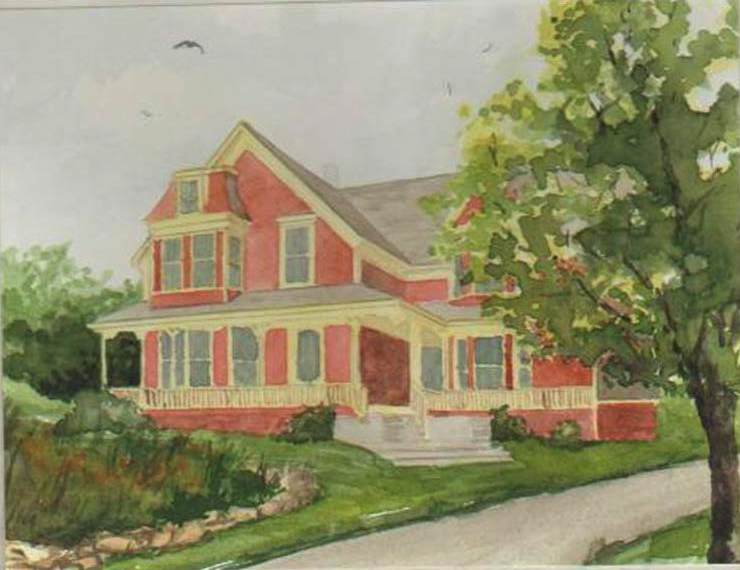 Oral tradition says the Captain Snow House, in the community of Port Wade, was built around 1895 by John Snow, a local sea captain, “along the lines of his Digby house”. It is said that Captain Snow captained, owned or had shares in over thirty vessels. Captain Snow also operated a ships chandler’s shop in a building across from the house and had a wharf on the Annapolis River just opposite his house.
Oral tradition says the Captain Snow House, in the community of Port Wade, was built around 1895 by John Snow, a local sea captain, “along the lines of his Digby house”. It is said that Captain Snow captained, owned or had shares in over thirty vessels. Captain Snow also operated a ships chandler’s shop in a building across from the house and had a wharf on the Annapolis River just opposite his house.
The Captain Snow House is truly of a style unique in the community of Port Wade. Built in front of an older, relatively unadorned structure, the Captain Snow House is primarily a Modified Gothic Style house; with Italianate and Queen Anne Revival influences as seen in its adornment of a two storey Italianate façade push-out, an open verandah supported by decorative posts and spindle work balustrades, decorated shingle work in the upper courses that accentuates the structure’s façade and ell and its use of hooded windows.
The Captain Snow House is a Municipal Heritage Property registered by the Municipality of Annapolis County, officially Registered October 17, 2006.
1759 Granville Road, Port Wade
Christ Church Anglican Church
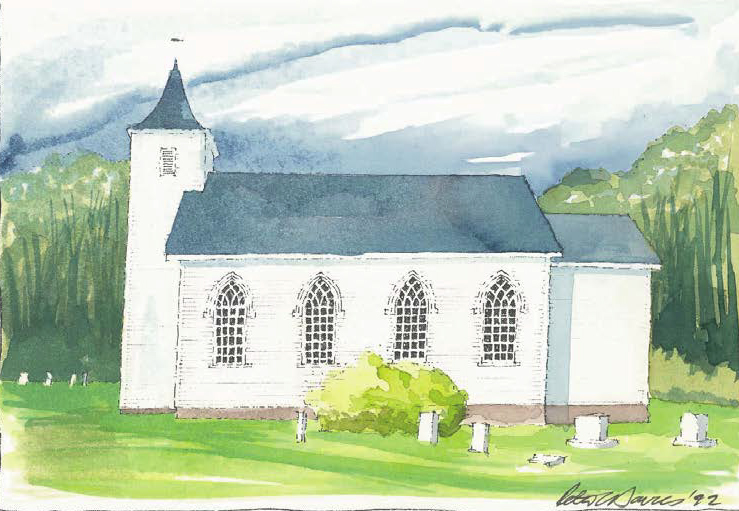 Originally called St. Paul’s Church, construction on Christ Church Anglican Church, Karsdale, was begun in 1790 and consecrated in 1793.
Originally called St. Paul’s Church, construction on Christ Church Anglican Church, Karsdale, was begun in 1790 and consecrated in 1793.
The church plan is traditional in form and features a square tower capped with a bell-cast roof, a rectangular nave lit by eight gothic style pointed windows and an east end chancel having a round headed classic style window. The window was added later from an area church.
This building is a Municipal Heritage Property registered by the Municipality of Annapolis County, officially registered, December 15, 1992.
3065 Granville Road, Karsdale
Church Grove Cemetery Church
 The historical significance of the Church Grove Cemetery Church, circa 1855, located in the community of Melvern Square, can be found in the fact that it was built by the Covenanters as a Covenanter Church.
The historical significance of the Church Grove Cemetery Church, circa 1855, located in the community of Melvern Square, can be found in the fact that it was built by the Covenanters as a Covenanter Church.
The Church Grove Cemetery Church building is a relatively unadorned single storey building constructed on a granite field-stone foundation in the Gothic Revival Architectural Style. Hallmark of this style is the emphasis on the vertical line in the building form as shown with the sharply pitched roof, front gable entranceway and pointed arch windows. One of the distinctive flairs is the use of the decorative curvilinear tracery of the front and side pointed arch windows. The idyllic location being surrounded by mature trees and well-kept cemetery grounds adds wonderfully to the visual appeal of the Church Grove Cemetery Church.
The Church Grove Cemetery Church is a Municipal Heritage Property registered by the Municipality of the County of Annapolis, officially registered April 20, 2010.
491 Stronach Mountain Road, Melvern Square
Davies/Repici House
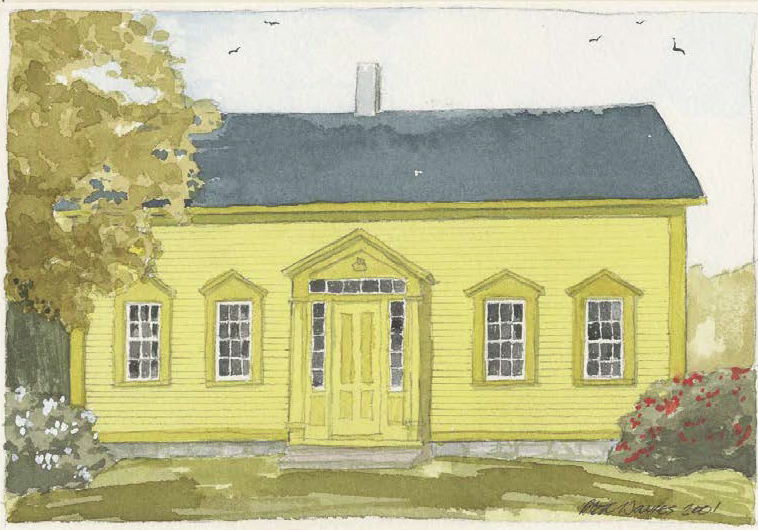 The Davies/Repici House, in the community of Port Royal, according to oral tradition was built by a master mariner, Captain William Greenwood, circa 1863. However, construction of the house may predate this date because the deed recorded in 1863 states that the property is the land on which the widow of the late William Greenwood resides. The historical significance of this house to the community can be found in the fact that the house was both used as a cook house when the railway was put through to Port Wade and Primrose Elliott, a former owner from 1906 to 1964, operated the Elizabeth Betts Public Library from the house in 1930.
The Davies/Repici House, in the community of Port Royal, according to oral tradition was built by a master mariner, Captain William Greenwood, circa 1863. However, construction of the house may predate this date because the deed recorded in 1863 states that the property is the land on which the widow of the late William Greenwood resides. The historical significance of this house to the community can be found in the fact that the house was both used as a cook house when the railway was put through to Port Wade and Primrose Elliott, a former owner from 1906 to 1964, operated the Elizabeth Betts Public Library from the house in 1930.
The Davies/Repici House is a wonderful example of vernacular architecture of the period featuring early Greek Revival style influences beautifully illustrating the period of evolution where architectural design elements are being incorporated in house construction for style adornment. Specific architectural features to note are that the house is a 1½ storey of wood construction with a medium pitch gable roof, featuring a central chimney, a five bay window façade with six over six windows decorated with gabled surrounds and an enclosed entry portico with rectangular transom and sidelights all in symmetrical placement.
The Davies/Repici House is a Municipal Heritage Property registered by the Municipality of Annapolis County, officially registered February 20, 2001.
3240 Granville Road, Port Royal
Emmanuel United Church
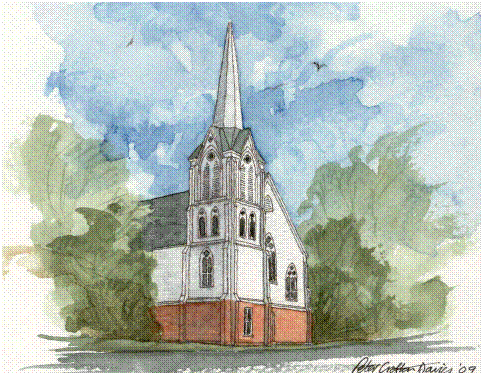 Emmanuel United Church, circa 1878, has a long history of adaptive reuse. The building, originally constructed as a Methodist Meeting Place, remained as such until 1925 when it became a United Church of Canada church building. Deconsecrated and sold in 1985, the building had been used during its more recent history as a pottery workshop and a dance studio with plans to become a private dwelling.
Emmanuel United Church, circa 1878, has a long history of adaptive reuse. The building, originally constructed as a Methodist Meeting Place, remained as such until 1925 when it became a United Church of Canada church building. Deconsecrated and sold in 1985, the building had been used during its more recent history as a pottery workshop and a dance studio with plans to become a private dwelling.
This former church building is a wonderful example of the Gothic Revival Architectural Style. Constructed of wood, the building resembles, albeit in a more simplified manner, the design of the Wesley Memorial Church in Oxford. UK. Hallmark of this style is balance and symmetry. The building with its steeply pitched front gable roof, pointed gothic windows, decorative dentil moldings, corner boards and immense off-set tower and spire forms both an impressive physical and picturesque community and streetscape presence.
The Emmanuel United Church property is a Municipal Heritage Property registered by the Municipality of the County of Annapolis, officially registered, March 18, 2008.
5439 Granville Road, Granville Ferry
Entertainment House
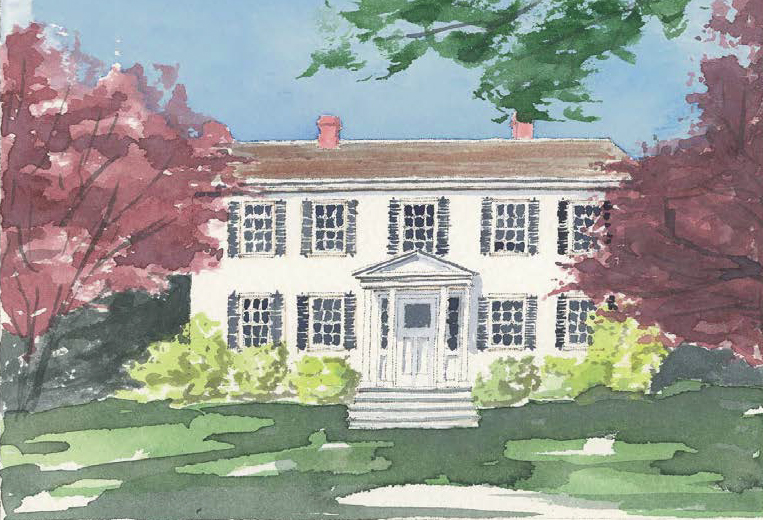 The Brother’s Lawrence and Harris Hall built this New England Colonial-style building circa 1827 and ran it as an inn, the Entertainment House.
The Brother’s Lawrence and Harris Hall built this New England Colonial-style building circa 1827 and ran it as an inn, the Entertainment House.
After the Hall’s the inn was owned by the Reed family for the next ninety years. Given the long use as an inn, this building is considered important to the historical development of Granville Ferry.
Tradition has the Halifax-Victoria Beach Pony Express changing horses at the inn during its brief existence.
This building is a Municipal Heritage Property registered by the Municipality of Annapolis County, officially registered, August 20, 1991.
5345 Granville Road, Granville Ferry
Evergreen United Baptist Church
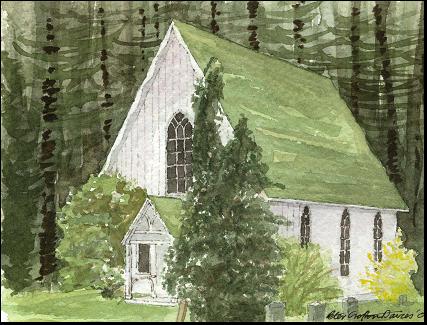 Originally known as The Central School House, construction of the Evergreen United Baptist Church was completed in 1859. The building, located in the community of West Paradise, was used for public worship, town business, a singing school, for lectures and as a meeting place for a debating society. Its dedication for use solely as a Church came in 1887.
Originally known as The Central School House, construction of the Evergreen United Baptist Church was completed in 1859. The building, located in the community of West Paradise, was used for public worship, town business, a singing school, for lectures and as a meeting place for a debating society. Its dedication for use solely as a Church came in 1887.
The Evergreen United Baptist Church is a single storey building constructed on a granite field-stone foundation which typifies the balance and symmetry characteristic of the Gothic Revival Architectural Style. Examples of this style can be found in the use of a traditional rectangular building form with a gable end roof and symmetrical door and window placement. The windows are the beauty points of the building, form the decorative tracery windows along the sides and above the front entrance. A distinctive flair is given to the exterior of the structure thanks to its board and batten cladding. With a few exceptions, very little has changed in the historic appearance of the Evergreen United Baptist Church.
The Evergreen United Baptist Church is a Municipal Heritage Property registered by the Municipality of Annapolis County, officially registered March 17th, 2009
5247 Highway 201, West Paradise
Goldenberg Apple House
 The Goldenberg APPLE HOUSE, located in the community of Carleton Corner is truly a story of adaptive reuse. Constructed in the early 1800’s, the Apple House was originally used as a schoolhouse in the community of West Dalhousie. Rather than demolishing the old schoolhouse, the building was dismantled and reconstructed on the Goldenberg property in 1868 where it was set up as a combined residence and cooperage for making apple barrels.
The Goldenberg APPLE HOUSE, located in the community of Carleton Corner is truly a story of adaptive reuse. Constructed in the early 1800’s, the Apple House was originally used as a schoolhouse in the community of West Dalhousie. Rather than demolishing the old schoolhouse, the building was dismantled and reconstructed on the Goldenberg property in 1868 where it was set up as a combined residence and cooperage for making apple barrels.
The Goldenberg APPLE HOUSE is a simple 1½ storey wood-frame construction, modestly adorned and uncluttered. The Apple House exhibits characteristics of the Greek Revival style highlighted in its temple pediment form and corner boards. Today, the Apple House continues as an intrinsic reminder of Annapolis County’s agricultural past.
The Goldenberg APPLE HOUSE is a Municipal Heritage Property registered by the Municipality of the County of Annapolis, officially Registered January 18, 2005.
4601 Highway 201, Carleton Corner
Old St. Alban's Church
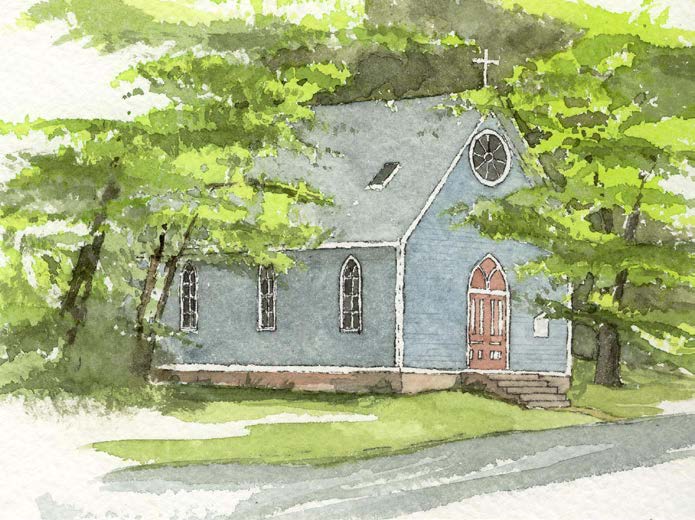 The Old St. Alban’s Church, in the Community of Lequille, is a wonderful example of adaptive reuse of a former church building. Built as the St. Alban’s Anglican Church; construction of the building began in 1892 with consecration in 1893.
The Old St. Alban’s Church, in the Community of Lequille, is a wonderful example of adaptive reuse of a former church building. Built as the St. Alban’s Anglican Church; construction of the building began in 1892 with consecration in 1893.
The Old St. Alban’s Church is constructed in the Gothic Revival Architectural style. Hallmark of this style is balance and symmetry. This is found in the use of the traditional rectangular building form with a gable end roof and symmetrical door and window placement. It is, however, the architectural details of the narrow gauge clapboard siding, pointed arch side windows with a front rosette window, the replication of the front entranceway along with its sympathetic north and south side additions and its blending into a compact streetscape that adds to the beauty of this former church building.
The Old St. Alban’s Church is a Municipal Heritage Property registered by the Municipality of the County of Annapolis, officially registered, May 20, 2008.
150 Old Trunk 8, Lequille
Paradise School
 Built in 1894, the present Paradise School is graciously set back from the main road and approached by s semi circular drive. The earlier school was sited within the driveway.
Built in 1894, the present Paradise School is graciously set back from the main road and approached by s semi circular drive. The earlier school was sited within the driveway.
It’s interest lies in the sue of the Second Empire style of architecture on a school, usually the plainest of buildings. Of note is the mansard roof, which originally sported a cupola, and tall, narrow french-style windows under round headed dormers.
Paradise School is a Municipal Heritage Property registered by the Municipality of Annapolis County, officially registered, January 19, 1993.
10307 Highway 1, Paradise
Merry House
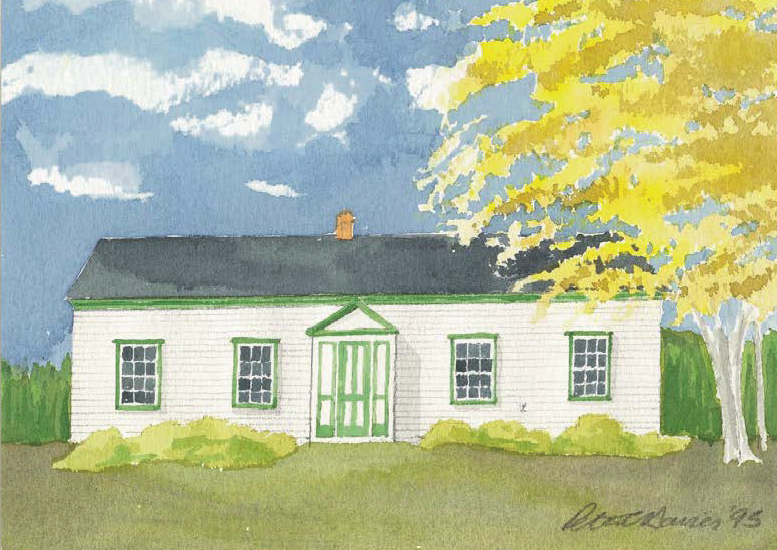 The Merry House, in the Community of Maitland, is a strong example of a Nova Scotia vernacular style house, devoid of decoration, but proportioned with a symmetrical façade, central chimney, boxed return eaves and six over six windows.
The Merry House, in the Community of Maitland, is a strong example of a Nova Scotia vernacular style house, devoid of decoration, but proportioned with a symmetrical façade, central chimney, boxed return eaves and six over six windows.
The first recorded deed for the Merry House (formerly known as the Dukeshire property) was 1871; however construction technologies employed in this house suggest a structure much older, possibly dating back to the 1820’s.
The Merry House has significant historical association for the community, reportedly being the site of the first post office in Maitland. According to oral tradition, the Merry Housewas also part of the stagecoach/pony express mail route in the mid 1800’s.
The Merry House is a Municipal Heritage Property registered by the Municipality of Annapolis County, officially registered, April 18, 1995.
1087 Highway 8, Maitland Bridge
Milford United Baptist Church
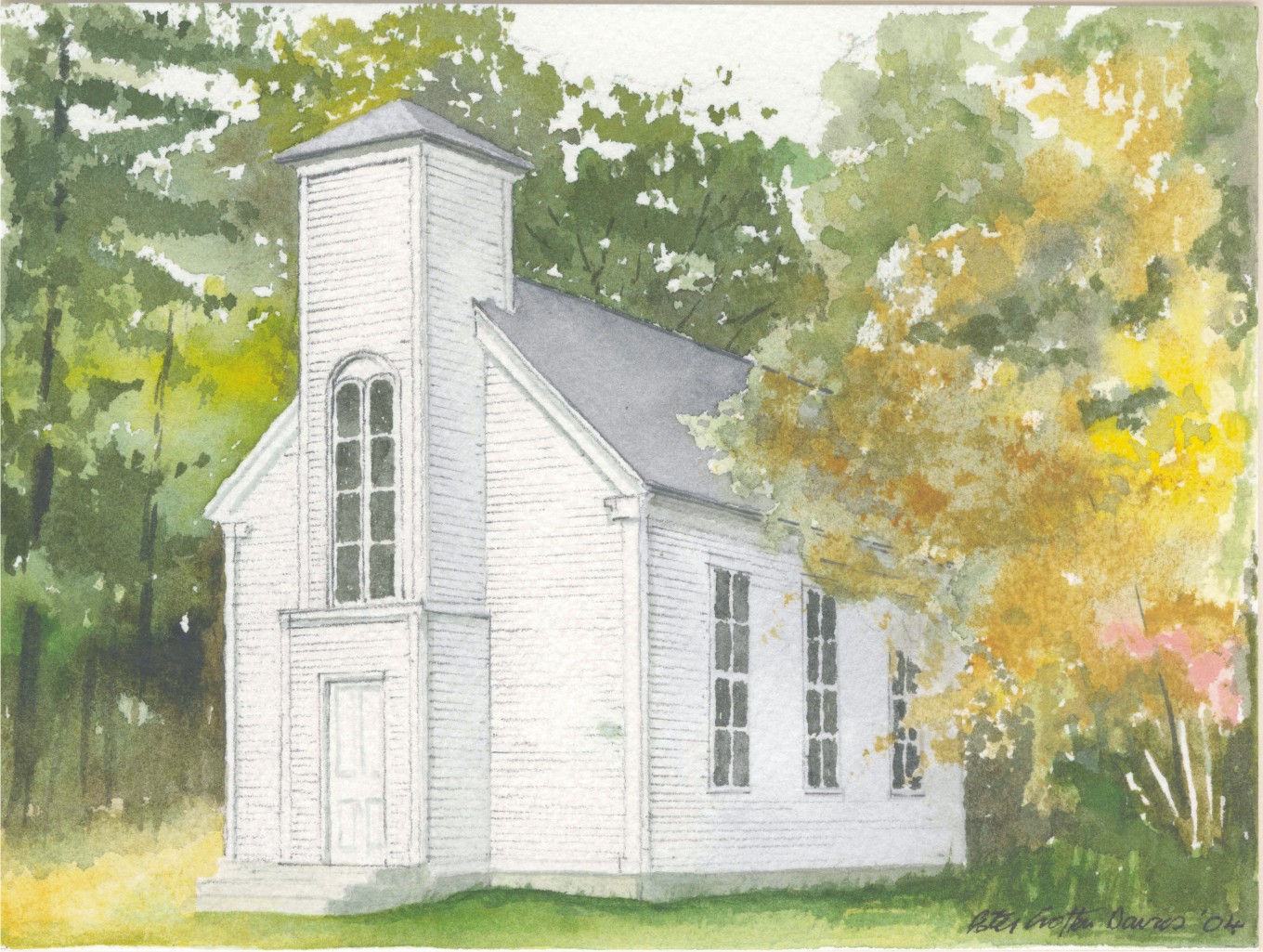 Construction of the Milford United Baptist Church began in 1890. The church is located on land purchased from Amos Hubley for the sum of five dollars. Ownership has not changed since the original deed registration date of January 1st, 1887.
Construction of the Milford United Baptist Church began in 1890. The church is located on land purchased from Amos Hubley for the sum of five dollars. Ownership has not changed since the original deed registration date of January 1st, 1887.
The Milford United Baptist Church building is a modestly adorned, uncluttered structure. It is constructed in the Greek Revival style highlighted by its temple pediment form supported by decorative pilasters and a projecting hipped-roof bell tower central entranceway. Romanesque-style rounded-arch windows also exemplify the transitional phase of Nova Scotia Baptist architecture from meeting house to country church.
The Milford United Baptist Church is a Municipal Heritage Property registered by the Municipality of Annapolis County, officially registered, September 21st, 2004.
5616 Highway 8, Milford
Solomon Bowlby House
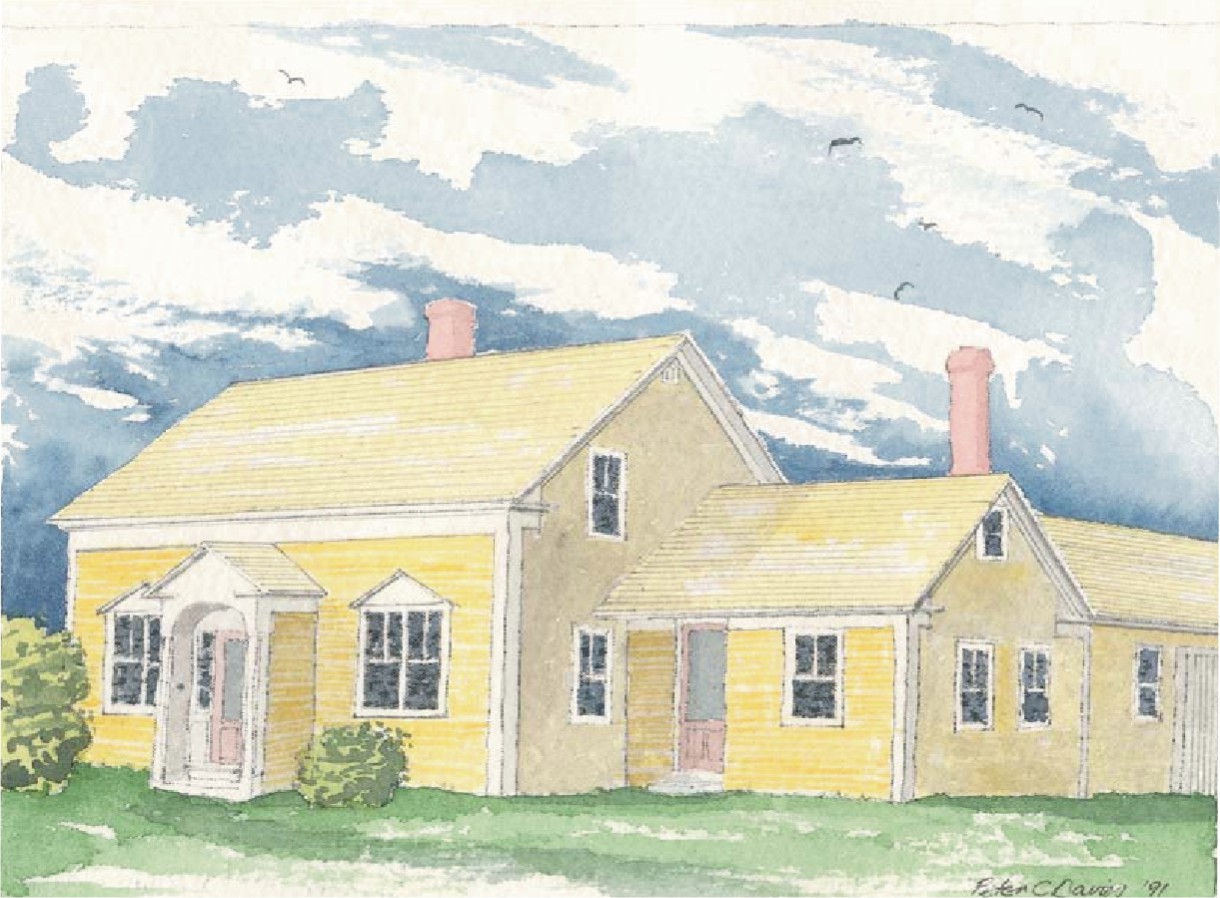 Built around 1855 by Solomon Bowlby, yeoman farmer, this house is a fine example of vernacular arehitecture of the period. New England Colonial influences are evident in the pitch of the roof, eave returns and pedimented rain hoods over the front door and windows.
Built around 1855 by Solomon Bowlby, yeoman farmer, this house is a fine example of vernacular arehitecture of the period. New England Colonial influences are evident in the pitch of the roof, eave returns and pedimented rain hoods over the front door and windows.
This house is the first property to be designated and registered as a heritage property by the Municipality of Annapolis County, officially registered February 19th, 1991.
2295 Highway 1, Upper Clements
St. Mark's Anglican Church
 St. Mark's Anglican Church, in the Community of Perotte was built by and located on the land donated by James Spurr. Originally a much smaller building, St. Mark's Anglican Church was constructed as a "Chapel of Ease" church building in 1834. While no date is available, the "Chapel" was enlarged at some point "to better serve the then-growing congregation" and consecrated on November 9, 1843.
St. Mark's Anglican Church, in the Community of Perotte was built by and located on the land donated by James Spurr. Originally a much smaller building, St. Mark's Anglican Church was constructed as a "Chapel of Ease" church building in 1834. While no date is available, the "Chapel" was enlarged at some point "to better serve the then-growing congregation" and consecrated on November 9, 1843.
The St. Mark's Anglican Church building is a wonderful example of Neo-classical Style Church Architecture. It is exemplified through the use of traditional rectangular building from, medium-pitched gabel roof with return eaves and corner pilasters and highlighted by the projecting hipped-roof bell tower with a templee pediment covered central entranceway and flat-headed rectangular side windows.
The St. Mark's Anglican Church is a Municipal Heritage Registered Property registered by the Municipality of Annapolis County, officially registered, May 17, 2005.
2553 Perotte Road, Perotte
Reuben Potter House
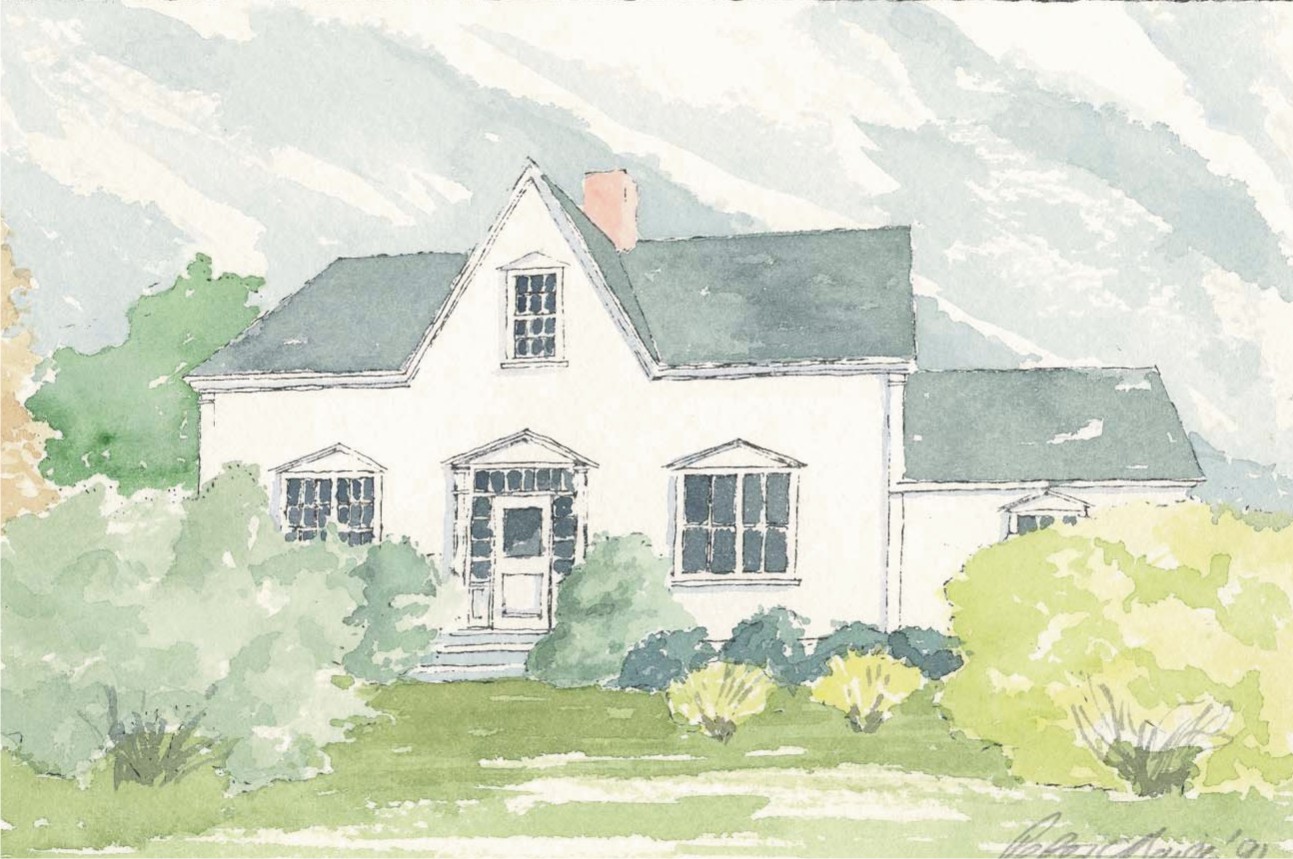 This house, built by REUBEN POTTER around 1853, is typical of many county farmhouses of this period.
This house, built by REUBEN POTTER around 1853, is typical of many county farmhouses of this period.
Its heritage value lies in the combination of a Gothic Revival building form with Greek Revival detailing as evidenced in the pedimented rainhoods, corner boards and the finely tapered pilaster columns supporting the main entrance. Of interest are the lead rainwater downspouts draining the now-covered eavestroughs.
The building is a Municipal Heritage Property registered by the Municipality of Annapolis County. December 17, 1991
1213 Clementsport Road, Clementsvale
St. John's Anglican Church
 Construction of St. John's Anglican Church, in the Community of Moschelle began in 1884 and was ready for services in 1886.
Construction of St. John's Anglican Church, in the Community of Moschelle began in 1884 and was ready for services in 1886.
The St. John's Anglican Church building is a wonderful example of the Gothic Revival Architectural Style constructed of locallyy made brick. Hallmark of this style is balance and symmetry. This is found in the use of the tradtional rectangular building form with a gable end roof and symmetrical door and window placement. It it, however, the architectural details of the front rosette window, the detailed brick work of the window surrounds, the decorative tracery side windows, wide frieze boards and ornate stained glass window in the narthex that add to the beauty fo the little brick church. The later bell tower addition with its shiplap siding, flared hip roof and crudiform is an excellent example of sympathetic construction that integrates new with old.
The St. John's Anglican Church is a Municipal Heritage Property registered by the Municipality of Annapolis County. Officially Registered October 12, 2005.
694 Highway 201, Moschelle
Tupperville School Museum
 The Tupperville School Museum, circa 1858, located in the community of Tupperville, was operated as a one-room schoolhouse, from 1858 to 1970. In 1972 it was converted to a school museum.
The Tupperville School Museum, circa 1858, located in the community of Tupperville, was operated as a one-room schoolhouse, from 1858 to 1970. In 1972 it was converted to a school museum.
The building is constructed in the Greek Revival Style with one of its most striking features being the symmetrically placed six over six Gothic Revival styled rolled glass windows. Overall, the Greek Revival Styling of the Tupperville School Museum, shows a structure reflecting a true sense of proportional balance and symmetry characteristic of a design movement employed in many of Nova Scotia's country schoolhouses and public buildings.
The Tupperville School Museum, is a Municipal Heritage Property, registered by the Municipality of Annapolis County, officially registered, March 21, 2000.
2663 Highway 201, Tupperville
Parker/Hawboldt House
 The Parker/Hawboldt House, in the community of Belleisle, was built in 1837 by Charles Parker, on lands originally deeded to his grandfather.
The Parker/Hawboldt House, in the community of Belleisle, was built in 1837 by Charles Parker, on lands originally deeded to his grandfather.
This structure is exemplary of an early evolution of Greek Revival and Gothic Revival elements in Nova Scotia. Construction is fo hand-hewn timbers connected by lap joints and wooden pegs. Specific architectural features of the house include return eves on front gable and gable roof, simple door surround with sidelights and ornamental mouldings and six-over-six windows in symmetrical alignment.
The home was constructed on the origianl Abijah Parker lands by his grandson. Abijah Parker was a New England Planter from Lunenburg, Worchester County, Massachusetts. Following in the Planter tradition, Charles Parker was also a farmer. Many generations of the Parker family lived in the house-two of the family members became quite prominent. Harry G. Parker was High Sheriff of Annapolis County from 1946 to 1962. E. T. Parker (Harry's brother), was appointed to the Supreme Court of Nova Scotia in 1948 and held that post for many years. This property remained in the Parker family for over 200 years, from an original grant dating 1759, until 1969.
This property is a Municipal Heritage Property registered by the Municipality of Annapolis County, officially registered May 31, 1996.
6601 Highway 1, Belleisle
St. Andrew's Anglican Church
 Built sometime between 1884 and 1850, St. Andrew's Anglican Church, Lawrencetown, reprensents a stylistic marriage of a Gothic Revival building with Neo Classical decorative elements.
Built sometime between 1884 and 1850, St. Andrew's Anglican Church, Lawrencetown, reprensents a stylistic marriage of a Gothic Revival building with Neo Classical decorative elements.
The Gothic Revival arrangement of square bell tower, nave and chancel, with Early English - type pointed windows to the nave and chancel, is coupled with Neo Classical pedimented gables and the unique polygonal drum and dome that cap the bell tower.
St. Andrew's Anglican Church is a registered Municipal Heritage Property in the Municipality of Annapolis County, officially registered, August 18, 1992.
579 Main Street, Lawrencetown
Upcoming Events
| Municipal Council Emergency Meeting 12 Sep 2025 12:00PM |
| Municipal Council 16 Sep 2025 10:00AM |
| East End Area Advisory Committee Meeting 17 Sep 2025 06:00PM |
| Notice of Public Hearing RE Number of Councillors and Altering of District Boundaries 27 Oct 2025 10:30AM |
New Information to This Site
- Council Extends State of Local Emergency as Wildfire Reaches Four Week Mark - September 12, 2025
- Procurement Opportunity : Electrical Contracting Services
- Special Council Meeting Highlights - September 9, 2025
- Evacuation Re-entry: Water Testing Information
- Employment Opportunity - Operations Coordinator
- Rural YOUTH Entrepreneurship Program for Annapolis County – Fall 2025
- State of Local Emergency Extended
- Navigator Program Introduced to Support Evacuees
- Evacuee Shelter Transition to Standby Status - September 4th
- West Dalhousie Wildfire: Re-entry Information for Evacuees
- West Dalhousie Wildfire - A message from Warden and Deputy Warden
- NS Government Matches Donations for Evacuees












